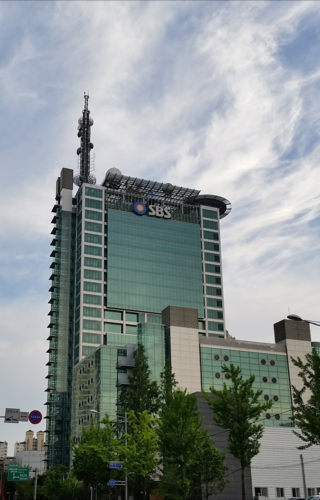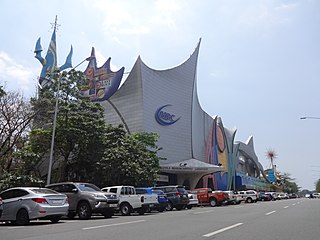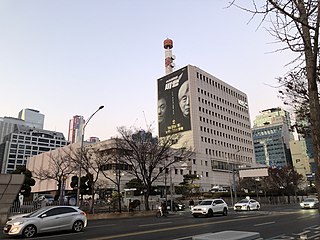Munhwa Broadcasting Corporation
Last updatedYou can help expand this article with text translated from the corresponding article in Korean. (September 2017)Click [show] for important translation instructions.
|
 Latin-alphabet logo used since 3 January 2005 | |
Native name | |
|---|---|
| Korean name | |
| Hangul | 주식회사 문화방송 |
| Hanja | 株式會社 文化放送 |
| Revised Romanization | Jusikhoesa Munhwa Bangsong |
| McCune–Reischauer | Chushikhoesa Munhwa Pangsong |
| Company type | Public broadcasting company |
| KRX: 052220 | |
| Industry | Broadcast radio and television |
| Founded | 21 February 1961 |
| Headquarters | 267, Sangam-dong, Mapo District, , |
Area served |
|
Key people | Ahn Hyung-joon, CEO and president (2023-present) [1] |
| Revenue | 1,500,941,912,398 won (2015) |
| 59,272,035,738 won (2015) | |
| 82,403,520,805 won (2015) | |
| Total assets | 2,557,227,645,206 won (December 2015) |
| Total equity | 1,000,000,000 won (December 2015) |
| Owner |
|
Number of employees | 1,712 (December 2015) |
| Subsidiaries | |
| Website | IMBC.com |
 |
| Part of a series on the |
| Culture of Korea |
|---|
| Society |
| Arts and literature |
| Other |
| Symbols |
|
Munhwa Broadcasting Corporation (MBC; Korean : 주식회사 문화방송; Hanja : 株式會社 文化放送; RR : Jusikhoesa Munhwa Bangsong;lit. "Joint-stock company Cultural Broadcasting") is one of the leading South Korean television and radio broadcasters. Munhwa is the Sino-Korean word for "culture". Its flagship terrestrial television station MBC TV broadcasts as channel 11.
Contents
- History
- Radio era (1961-1968)
- Black and white TV era (1969-1980)
- Colour TV era (1980-1990)
- Multimedia era (1991-2000)
- Digital era (2001–present)
- International relations
- Channels
- Headquarters
- Logos
- See also
- References
- External links
Established on 2 December 1961, MBC's terrestrial operations has a nationwide network of 17 regional stations. Although it operates on advertising, MBC is a Network Radio Television as its largest shareholder is a public organization, the Foundation of Broadcast Culture. MBC consists of a multimedia group with one terrestrial TV channel, three radio channels, five cable channels, five satellite channels and four DMB channels.
MBC is headquartered in Digital Media City (DMC), Mapo District, Seoul and has the largest broadcast production facilities in Korea including digital production centre Dream Center in Ilsan, indoor and outdoor sets in Yongin Daejanggeum Park.
History
Radio era (1961-1968)
Launching the first radio broadcast signal (call sign: HLKV, frequency: 900 kHz, output: 10 kW) from Seoul, MBC started as the first non-governmental commercial broadcaster in Korea. On 12 April 1963, it obtained a license from the government for operating regional stations in major cities (Daegu, Gwangju, Daejeon, Jeonju) in Korea, and established a broadcast network which connects six cities including Seoul and Busan.
Black and white TV era (1969-1980)
MBC launched TV broadcasting on 8 August 1969 (call sign: HLAC-TV, output: 2 kW), and started to broadcast its main news program MBC Newsdesk on 5 October 1970. It reached affiliation deal with 7 commercial stations (in Ulsan, Jinju, Gangnueng, Chuncheon, Mokpo, Jeju, Masan) between 1968 and 1969, and started nationwide TV broadcasting through its 13 affiliated or regional stations. In 1974, FM radio was launched, and MBC took over the Kyunghyang Shinmun (daily newspaper company).
Colour TV era (1980-1990)
The first colour TV broadcasting was started on 22 December 1980. MBC was separated from the Kyunghyang Shinmun according to the 1981 Basic Press Act. In 1982, it moved into the Yeouido headquarters. That same year, the network founded its baseball team, MBC Cheong-ryong (Blue Dragon), which entered the KBO League as a charter team, in addition to the network being the first home of the league's TV broadcasts. With the live coverage of the 1986 Seoul Asian Games and the 1988 Seoul Olympic Games, MBC made a great advancement in scale and technology.
Ownership of the Blue Dragon was passed to LG Corporation in 1989.
Multimedia era (1991-2000)
After rapidly growing into a large corporation, covering major international events, MBC established specialized companies for each value chain (MBC Production, MBC Media Tech, MBC Broadcast Culture Center, MBC Arts Company, MBC Arts Center) and spined them off as subsidiaries to become a more efficient corporation amid fiercer competition in the multimedia era. ※ MBC Production and MBC Media Tech were merged into MBC C&I in August, 2011.
Digital era (2001–present)
As the convergence of broadcasting and communications becomes full-fledged, MBC made its subsidiary iMBC (internet MBC) an independent corporation and pursued various internet-related business. Furthermore, it started cable TV (MBC Plus Media,) satellite TV, new DMB broadcasting and full daytime broadcasting on terrestrial television. In 2007, MBC established digital production centre Ilsan Dream Center, which is equipped with high-tech production facilities. In September 2014, it completed the construction of a new headquarters building and moved from Yeouido to Sangam-dong, opening a new era of Sangam MBC.
In 2001, MBC launched satellite and cable television broadcasting. As part of this expansion it created MBC America, a subsidiary based in Los Angeles, United States, to distribute its programming throughout the Americas. On 1 August 2008, MBC America launched MBC-D, a television network carried on the digital subchannels of KSCI-TV, KTSF-TV, and WMBC-TV. The service was planned to be launched in Atlanta, Chicago, and Washington, D.C. by the end of the year. [2] In northeast metro Atlanta, it aired on WKTB-CD channel 47.3 (now a Telemundo affiliate), but as of 2011 is on WSKC-CD channel 22.1.
In March 2013, computer shutdowns hit South Korean television stations, including MBC. [3] The South Korean government asserted a North Korean link in the March cyberattacks, which has been denied by Pyongyang. [4]
International relations
MBC is an active member of international organizations such as ABU (Asia-Pacific Broadcasting Union), IATAS (International Academy of Television Arts & Science) and INPUT (International Public Television Screening Conference), and is affiliated with 21 broadcasters in 13 countries.
It is engaged in various global business through overseas corporations in Los Angeles and Shanghai, and bureaus in North America, Latin America, Europe and the Middle East as well as Asia, in close cooperation with major global media groups.
MBC is devoted to entering foreign markets and expanding the business area. It maintains a close relationship with foreign buyers by participating in major content markets every year such as MIP-TV, MIPCOM, NATPE, BCWW and ATF. It operates an English website which introduces various MBC content to the overseas buyers and viewers so that they can easily access its content.
MBC drama What on Earth Is Love? is the first Korean Wave drama which sparked the K-drama boom across China, when it was aired on CCTV in 1997. Since then, numerous MBC dramas, entertainment shows, and documentaries have been exported to different countries. The drama Dae Jang Geum was shown in as many as 91 countries around the world. More recently, MBC is widening its content business area by exporting show formats such as I Am a Singer, We Got Married and Dad! Where Are We Going? to other countries.
Channels
- One terrestrial TV (MBC TV — channel 11)
- Three radio stations:
| Name | Frequency | Power (kW) |
|---|---|---|
| MBC Standard FM | 95.9 MHz FM | />10 kW (FM) |
| MBC FM4U | 91.9 MHz FM | 10 kW |
| Channel M | CH 12A DAB | 2 kW |
- Five cable/satellite (MBC Drama, MBC Sports+, MBC M, MBC every1 and MBC ON)
- Three terrestrial DMB (TV, radio, data)
- Two satellite DMB (MBC Drama, MBC Sports+)
Headquarters
- MBC Dream Center located in Goyang, Gyeonggi Province (30 November 2007 – present).
- Old MBC headquarters located in Yeouido (17 February 1982 – 3 August 2014).
- Old MBC building located in Jeong-dong (8 August 1969 – 16 February 1982; now used by Kyunghyang Shinmun).
Logos
- First MBC logo (used 1961 to 1969)
- Second MBC logo (used 1969 to 1974)
- Third MBC logo (used 1974 to 1980)
- Fourth MBC logo (used 1980 to 1981)
- Fifth MBC logo (used 1981 to 1985)
- Sixth MBC logo (used 1981 to 1985)
- Seventh MBC logo (used 1986 to 2005)
See also
Related Research Articles
Digital radio is the use of digital technology to transmit or receive across the radio spectrum. Digital transmission by radio waves includes digital broadcasting, and especially digital audio radio services.

The Korean Broadcasting System is the national broadcaster of South Korea. Founded in 1927, it is one of the leading South Korean television and radio broadcasters.
In South Korea, there are a number of national television networks, the three largest of which are KBS, MBC, and SBS. Most of the major television studios are located on Yeouido and Sangam-dong, Seoul. South Korea became the fourth adopter in Asia when television broadcasting began on 12 May 1956 with the opening of HLKZ-TV, a commercially operated television station. HLKZ-TV was established by the RCA Distribution Company (KORCAD) in Seoul with 186–192 MHz, 100-watt output, and 525 scanning lines.

Seoul Broadcasting System (SBS) is one of the leading South Korean television and radio broadcasters. The broadcaster legally became known as SBS in March 2000, changing its corporate name from Seoul Broadcasting System. Its flagship terrestrial television station SBS TV broadcasts as channel 6 for digital and cable.
MBC may refer to:
Television in Hong Kong is primarily in Cantonese and English. It is delivered through analogue and digital terrestrial, cable, IPTV, and the Internet. Satellite TV is not common, although many housing estates have dishes and re-distribute a limited number of free channels through coaxial cables. The dominant broadcaster is TVB, ViuTV and HOY TV.

The Manila Broadcasting Company, doing business as the MBC Media Group, is a multimedia company in the Philippines. MBC Media Group is currently owned by the FJE Group of Companies of Fred J. Elizalde, which also operates hotels and Pasay-based amusement park, Star City. Its AM flagship network, DZRH is the oldest radio station in the country while its FM flagship network, Love Radio is the top station in FM radio ratings in Metro Manila and several key cities and provinces.
S-DMB (Satellite-DMB) was a hybrid version of the Digital Multimedia Broadcasting. The S-DMB used the S band (2170-2200 MHz) of IMT-2000. and delivered around 18 channels at 128 kbit/s in 15 MHz. It incorporated a high power geostationary satellite, the MBSat 1. For outdoor and light indoor coverage is integrated with a terrestrial repeater network for indoor coverage in urban areas.
Mobile television is television watched on a small handheld or mobile device, typically developed for that purpose. It includes service delivered via mobile phone networks, received free-to-air via terrestrial television stations, or via satellite broadcast. Regular broadcast standards or special mobile TV transmission formats can be used. Additional features include downloading TV programs and podcasts from the Internet and storing programming for later viewing.

The South Korean mass media consist of several different types of public communication of news: television, radio, cinema, newspapers, magazines, and Internet-based websites.
CTV 2 Alberta is a Canadian English language entertainment and former educational television channel in the province of Alberta. Owned by the Bell Media subsidiary of BCE Inc., it operates as a de facto owned-and-operated station of its secondary CTV 2 television system.
Television in the Philippines was introduced in October 1953 upon the first commercial broadcast made by Alto Broadcasting System, making the Philippines the first Southeast Asian country and the second in Asia to do so. Even before that, during the late 1940s, several academic experiments had been done and replicated by Filipino engineers and students.
Television in Japan was introduced in 1939. However, experiments date back to the 1920s, with Kenjiro Takayanagi's pioneering experiments in electronic television. Television broadcasting was halted by World War II, after which regular television broadcasting began in 1950. After Japan developed the first HDTV systems in the 1960s, MUSE/Hi-Vision was introduced in the 1970s.

Digital multimedia broadcasting (DMB) is a digital radio transmission technology developed in South Korea as part of the national IT project for sending multimedia such as TV, radio and datacasting to mobile devices such as mobile phones, laptops and GPS navigation systems. This technology, sometimes known as mobile TV, should not be confused with Digital Audio Broadcasting (DAB) which was developed as a research project for the European Union.

JTBC is a South Korean nationwide pay television network. Its primary shareholder is JoongAng Holdings, with a 25% stake. It was launched on 1 December 2011. JTBC is a generalist channel, with programming consisting of television series, variety shows, and news broadcasting; its news division is held in similar regard to the three main terrestrial networks in South Korea.

Channel A Corporation, known as Channel A, is a nationwide generalist cable TV network and broadcasting company in South Korea. The company's largest shareholder is Dong-A Media Group (DAMG), which consists of 12 affiliate companies including The Dong-a Ilbo. Channel A was launched on 1 December 2011. Channel A's management philosophy is 'Open & Creative' and the company slogan is 'Channel A, A Canvas that Holds Your Dreams.' JaeHo Kim is the chief executive officer.

Tongyang Broadcasting Company was a South Korean commercial television station which was merged by the government with KBS. It was owned by the Samsung Group founder Lee Byung-chul.
Korea Broadcast Advertising Corporation (KOBACO) is the only media representative in South Korea operating as an agency that represents every terrestrial broadcasting company of South Korea for their broadcast advertising sales. KOBACO was established in 1981 and it was re-established as a government-funded public media representative in May 2012.

MBC TV is a South Korean free-to-air television channel and is considered the first private company in South Korea launched on 8 August 1969 and owned by Munhwa Broadcasting Corporation.
References
- ↑ "Broadcaster MBC confirms new CEO appointment". 23 February 2023. Archived from the original on 1 March 2023. Retrieved 1 March 2023.
- ↑ "Archived copy". Archived from the original on 2 April 2015. Retrieved 2 August 2008.
{{cite web}}: CS1 maint: archived copy as title (link) - ↑ Choe, Sang-Hun (20 March 2013). "Computer Networks in South Korea Are Paralyzed in Cyberattacks". The New York Times . Archived from the original on 2 June 2019.
- ↑ Lee Minji (10 April 2013). "(2nd LD) Gov't confirms Pyongyang link in March cyber attacks". Yonhap News . Archived from the original on 15 April 2013. Retrieved 2 June 2019.





